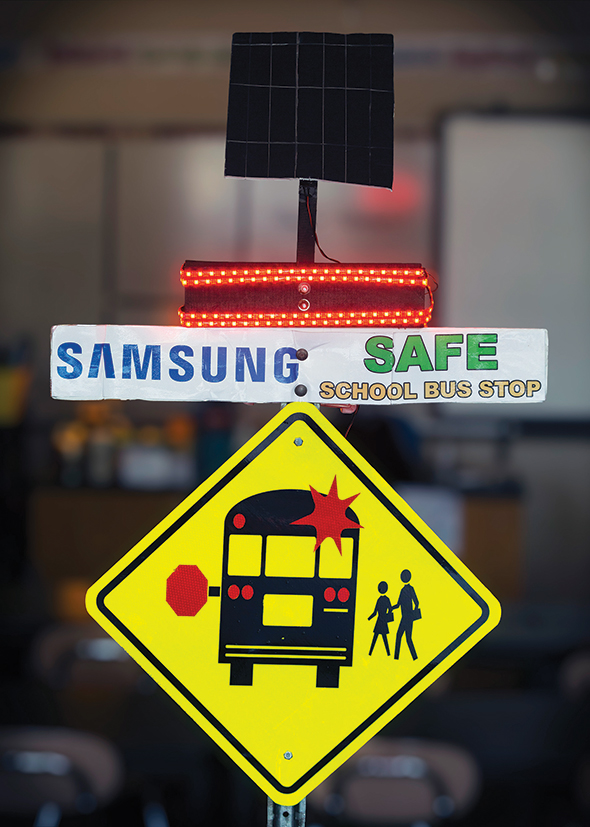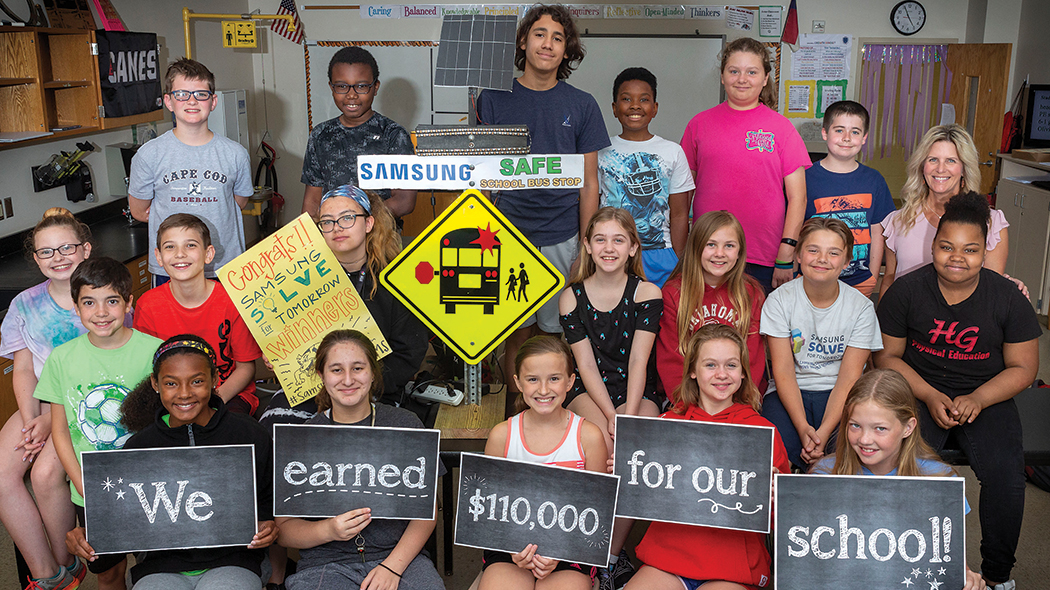“The food.”
That was Reanna Robertson’s favorite part about her recent trip to New York.
A close second was winning the national grand prize in the Samsung Solve for Tomorrow contest with her teammates at Holly Grove Middle School in Holly Springs.
Reanna was one of 19 sixth-grade students who answered teacher Debra Schelin’s call for contest participants back in September.
Schelin, a sixth-grade science teacher, had received an email about the nationwide contest and decided to mentor a team during the school’s daily enrichment period.
“It seemed like a neat way for a real life opportunity to learn,” she said.

The team designed a school bus stop sign that alerts motorists when a bus is approaching the stop with a series of flashing lights.
Samsung’s Solve for Tomorrow contest is designed to foster interest in the STEM subjects: science, technology, engineering and math, and to show how those subjects can be used to improve the local community.
The team at Holly Grove Middle School selected bus stop safety as the topic of their project after learning that one of their classmates was almost hit crossing the road at a bus stop. With several bus riders in the group, the students understood this was an ongoing concern.
“I think we all experience it,” Reanna said, of dangerous street crossings or unaware drivers.
The group brainstormed several ideas, including seatbelts and bus stop cameras, but settled on a proximity-activated bus stop sign that alerts drivers when a bus is coming with a series of flashing lights.
First, bus drivers select what route they are going to take in a cell phone app — an app created by the students themselves. The bus and the stop sign are equipped with wireless transmitters and as the bus approaches, the sign comes alive.
“At 400 ft. the lights will start to slow flash yellow, they strobe yellow at 200 ft. and at 30 ft. they flash red,” said Reanna.
The contest had several rounds, including a written proposal, an explanatory video and in-person presentations in New York City and Washington D.C. Along the way the students learned how to code the app and use technologies like an XBee (wireless transmitter) and an Arduino (a programmable circuit board).
“They found their strengths within the project. They would go work on the video or work on the community part of it,” said Schelin. “They found within themselves what their talents were.”
“When we won the state, we won $20,000,” said Schelin. “I kept checking my email thinking, ‘Am I reading this right?’ And that was all just writing.”
Turning the written plan into a working prototype and video presentation for the contest’s third round took countless hours, which the students gave willingly.
“The students ended up coming in while they were tracked out almost every single day. Up until that, they were working on it during their lunch period and after school. It was all on their own time,” said Heather Lawing, senior administrator of communications with Wake County Public Schools.
“Because the group was so big, they held auditions to select who would give the presentations in New York and D.C.,” said Lawing.
What’s more challenging than presenting in front of judges in N.Y.C.? Practicing the presentation in front of other classes at Holly Grove.
“We had to go to classes that were different tracks. It was kind of embarrassing. It’s always harder to present to kids in your school,” said Jasper Cekander.
When the grand prize winners were announced in New York, the Holly Grove team was taken by surprise.
“We had just won the community choice award [by receiving the most online votes]; we weren’t really expecting to also get the grand prize,” said Evan Kruger.
“There were lots of phone calls and lots of screaming,” said Schelin, who alerted the students back in N.C. through a “really excited” message on the team’s group chat.
“They were celebrated like rock stars, like they would be for any state or national victory. We want to celebrate our academic achievements as much as we would any athletic achievement,” said Lawing.
“There was a big pep rally for the entire school. We got to run in breaking a banner,” said Jasper.
As one of three grand prize winners, the team won $100,000, plus $10,000 as the community choice winner in technology and instructional supplies for the school.
A second group of students travelled to Washington D.C. to present their project to congressional representatives, including Rep. Jackie Walorski from Indiana who recently introduced the Stop for School Buses Act to improve bus traffic safety.
“I feel like it was a once in a lifetime experience — though I do think we’ll enter again,” said Schelin. “The whole journey was amazing from start to finish.”
Several students are already committed to entering the contest another time.
“I want to do it again. I started thinking about an idea for next year when we found out we won,” said Jasper.
Lawing said, “This is pretty powerful for the youngest kids in the school to have won so much. To have had such a big impact and to show the whole school that you’re never too young; you’re never too small. When you set your mind to something, you can accomplish big goals.”
- Lindsey Evans
- Greensboro Science Center
- Ironweed: Purple Reign
- Your “Back-to-School” Personality According To Town
- Love the Game
- Hell Yes Ma’am Belgian Golden Ale from Raleigh Brewing Company
- Vicious Fishes Brewery, Tap & Kitchen
- Conniption Gin Rosé Spritz from Durham Distillery
- Winner, Winner
- Hunting for Home






